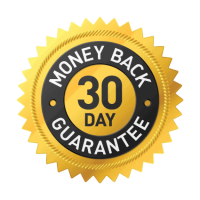The Battery & Whitepoint Gardens
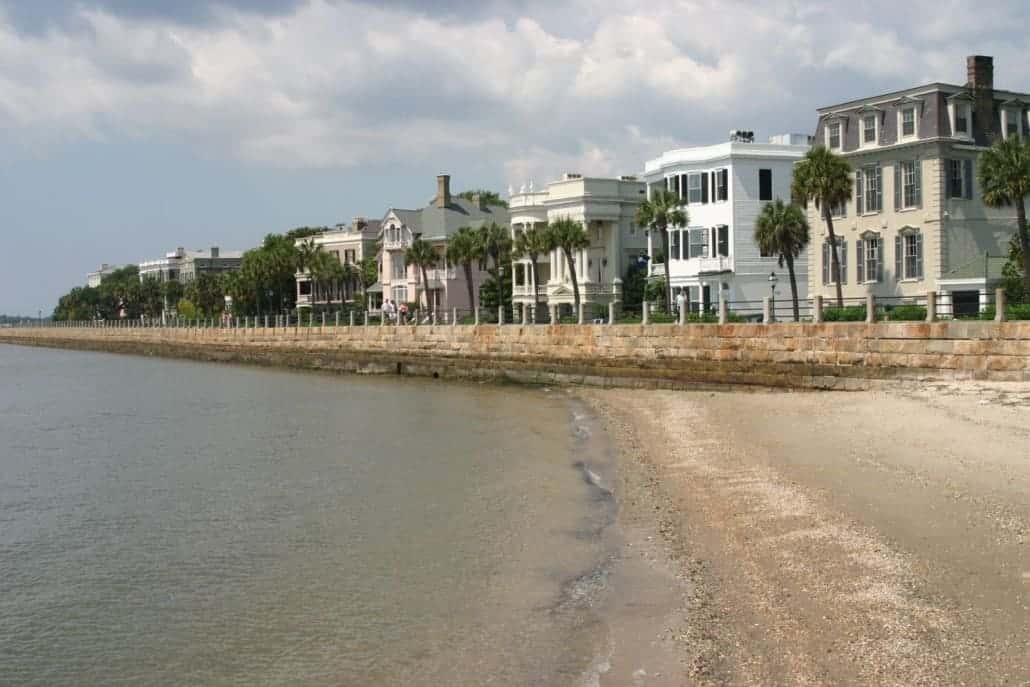
Named for a civil-war coastal defense artillery battery at the site, it stretches along the lower shores of the Charleston peninsula, bordered by the Ashley and Cooper Rivers, which meet here to form Charleston harbor. Historically, it has been understood to extend from the beginning of the seawall at the site of the former Omar Shrine Temple (40-44 East Bay Street) to the intersection of what is now Murray Boulevard and King Street. The higher part of the promenade, paralleling East Battery, as the street is known south of Water Street, to the intersection of Murray Boulevard, is known as High Battery. Fort Sumter is visible from the Cooper River side (High Battery) and the point, as is Castle Pinckney, the World War II aircraft carrier USS Yorktown (CV-10), Fort Moultrie, and Sullivan’s Island.
Fort Broughton (ca. 1735) and Fort Wilkins (during the American Revolution and War of 1812) occupied White or Oyster Point, so named because of the piles of bleached oyster shells on the point at the tip of the peninsula. In the 18th century, rocks and heavy materials were used to fortify the shore of the Cooper River on the eastern side of the peninsula. In 1838, this area of the Battery, known as High Battery, became a promenade. First used as a public park in 1837, the area now known as White Point Garden became a place for artillery during the American Civil War.
In popular speech and in a number of unofficial guidebooks and Web sites, The Battery and White Point Garden are sometimes referred to as “Battery Park,” but the park and seawall promenade are not regarded by the City of Charleston as a single entity, and the term “Battery Park” is not an official designation.
In 2004, a structural report by the City of Charleston showed that the Battery was suffering serious problems and could fail to protect the southeastern portion of the city during hurricanes. In 2012, the City announced that a $3.2 million restoration project would soon commence at the conjure of High Battery (along East Battery) and Low Battery (along Murray Blvd.).
Sullivan’s Island
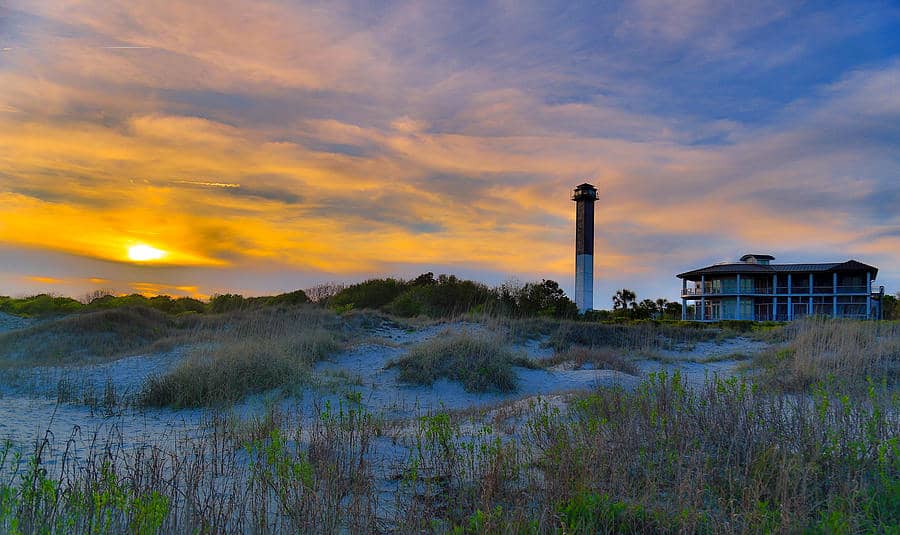
The Town of Sullivans Island, a barrier island north of the Charleston harbor, has only about 2,000 residents. With its unspoiled views and terrific dining options, Sullivans is a favorite among Charleston area locals. The beach has few short-term rentals and no hotels so plan a day trip to this beach, also located just a few minutes from the Isle of Palms.
Where to park: Parking can be a problem if you arrive after 10 a.m. There are no public parking lots, and street parking is allowed on one side of the street only. Be sure to obey posted signs and do not park in any private yards or driveways.
Poes Tavern on Sullivans Island Lunch break: Poes Tavern, 2210 Middle St., is named for Edgar Allan Poe, who, at the age of 18, enlisted in the Army and was stationed at Fort Moultrie. A favorite among locals and visitors, Poes menu is filled with gourmet burgers (try the Black Cat with grilled onions, chili, bacon and pimento cheese) and fish tacos (order the citrus-marinated mahi-mahi).
Beach beers: Dunleavys Pub, 2213 Middle St., is a family owned Irish pub with a long history on the island. Unwind with a cold beer after a long, hot day on the beach.
Dinner by the ocean: The Obstinate Daughter, 2063 Middle St., is a southern restaurant with Spanish, Italian and French influences. The menu is packed with small plates, pasta and gourmet pizzas. Try the Lowcountry shrimp roll or butterbean ravioli topped off with a glass of wine.
Sullivans Island Best selfie spot: Built in 1962, the modern-looking Sullivans Island Lighthouse sits just off the shore adjacent to Fort Moultrie. Access is via Station 18 1/2.
Rules to know: Sullivans Island has no public restrooms or showers and there are no lifeguards on duty. Alcohol is not permitted on the beach. All dogs visiting the island must have a dog permit and should wear the town-issued collar while on Sullivans Island. Permits and collars are available at Town Hall, 2050-B Middle St. 843-883-3198. Dogs are not allowed on the beach during certain times in the summer season. More info and complete beach rules: https://sullivansisland-sc.com
Sullivans Island fun fact: This Island has a long military history of protecting the Charleston harbor from invaders. Visit Fort Moultrie, originally built with palmetto logs in 1776, to how it has been restored to reflect the story of American seacoast defense up through World War II.
St. Phillips Church & Graveyard
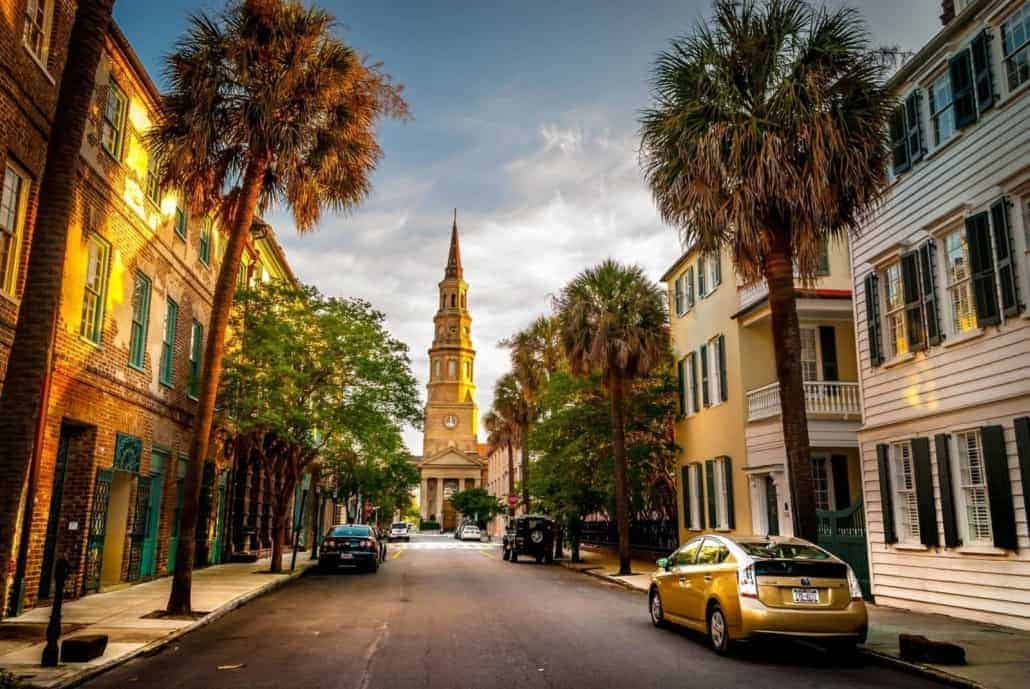
Building and graveyard are open to the public Mon-Fri 10am to 12pm and 2pm to 4pm.
Established in 1681, St. Philip’s is the oldest religious congregation in South Carolina. The first St. Philip’s Church, a wooden building, was built between 1680 and 1681 at the corner of Broad and Meeting streets on the present day site of St. Michael’s Episcopal Church. It was damaged in a hurricane in 1710 and a new St. Phillip’s Church was begun a few blocks away on Church Street. After being delayed it was finished in 1723 but burned to the ground in 1835. Work on the present church was begun that same year and completed the next. The steeple was added between 1848 and 1850.
Many prominent people are buried in the graveyard, which is divided into two parts. The western yard was initially set aside for the burial of “strangers and transient white persons,” but church members were later buried there. Several colonial Governors and five Episcopal bishops are buried here, as well as John C. Calhoun (former Vice President of the United States), Rawlins Lowndes (President of South Carolina in 1778-79), and Dubose Heyward (author and playwright).
The view of Church Street punctuated by St. Philip’s remains one of Charleston’s most photographed spots.
St. Michael’s Church & Graveyard

If the doors are open you are able to step inside and visit the church.
St. Michaels Church is the oldest church edifice in the City of Charleston, standing on the site of the first Anglican Church built south of Virginia.
In 1680 a small wooden church, the first in the new town of Charles Town, was built on this spot for the families of the Church of England, and named St. Philips. By 1727, the town had grown too large for the small church and a more spacious one was built of brick on Church Street, later destroyed by fire in 1835. By 1751, St. Philips had again proved too small for the increasing population, and another church as authorized by the General Assembly of the Province, to be built on the old site and to be known as St. Michael’s. The cornerstone was laid in 1752 and in 1761 the church was opened for services. Except for the addition of the sacristy in 1883 on the southeast corner, the structure of the building has been little changed.
The large, long double-pew in the center of the church, No. 43, originally known as “The Governors Pew, is the one in which President George Washington worshiped on Sunday afternoon, May 8, 1791. General Robert E. Lee also worshiped in the pew some seventy years later. The pews, of native cedar, are very much the same as they have always been except for the addition of ten, filling up what was once an aisle from the south door to a north door (now filled by the “Annunciation” window), thus originally making a cruciform design with the main (east-west) aisle.
John Rutledge, the first Governor of SC, signer of the Declaration of Independence and US Constitution is buried in the graveyard here.
SC Historical Society Museum
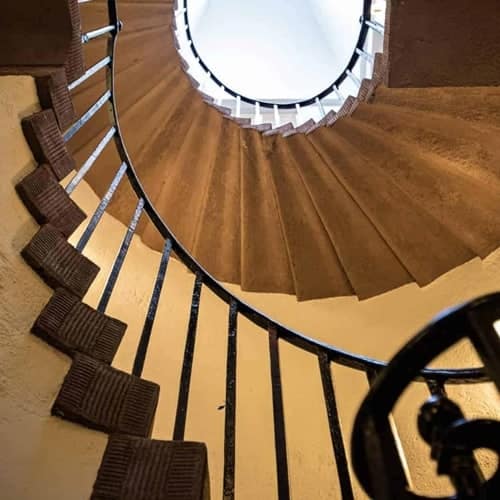
Immerse yourself in the history of South Carolina!
Although founded in 1855 as an archive and private manuscript repository, the South Carolina Historical Society opened its first museum open to the public in September 2018. The new space pairs personal manuscripts, maps, and artifacts with innovative technology as visitors experience illuminating moments in our past.
The newly remodeled, repurposed Fireproof Building is the home of the Historical Society headquarters. The National Historic Landmark houses a new, state-of-the art museum with interactive exhibits that showcase South Carolina history, culture, and arts. Designed by Robert Mills and constructed between 1822 and 1827, the Fireproof Building is believed to be the first of its kind constructed in the United States.
Highlights:
- Informational exhibits.
- Self guided tours.
- Wheelchair accessible.
The museum is closed Easter Sunday, Thanksgiving, Christmas Eve, New Year’s Eve and New Year’s Day.
Riley Waterfront Park & Pineapple Fountain

The Charleston Water Taxi departs from the dock here! Relax on the large dock swings, see dolphins in the harbor play, admire the amazing view of the Charleston harbor and get a photo by the iconic Pineapple Fountain.
The park received the 2007 Landmark Award from the American Society of Landscape Architects and the National Trust for Historic Preservation. This award “recognizes a distinguished landscape architecture project completed between 15 and 50 years ago that retains its original design integrity and contributes significantly to the public realm of the community in which it is located.”
The location of the park, between Vendue Range to the north and Adger’s Wharf to the south, had historically been a center of maritime traffic with several wharfs and shipping terminals. The area entered a long period of decline, capped in June 1955 by a fire at a steamship terminal at the site.
By 1980, the site was an “overgrown area marred by charred pilings and gravel parking lots.” Mayor Joseph P. Riley, Jr. began making plans for a park on the site soon after taking office in 1975 after whom the park is named.
Rainbow Row
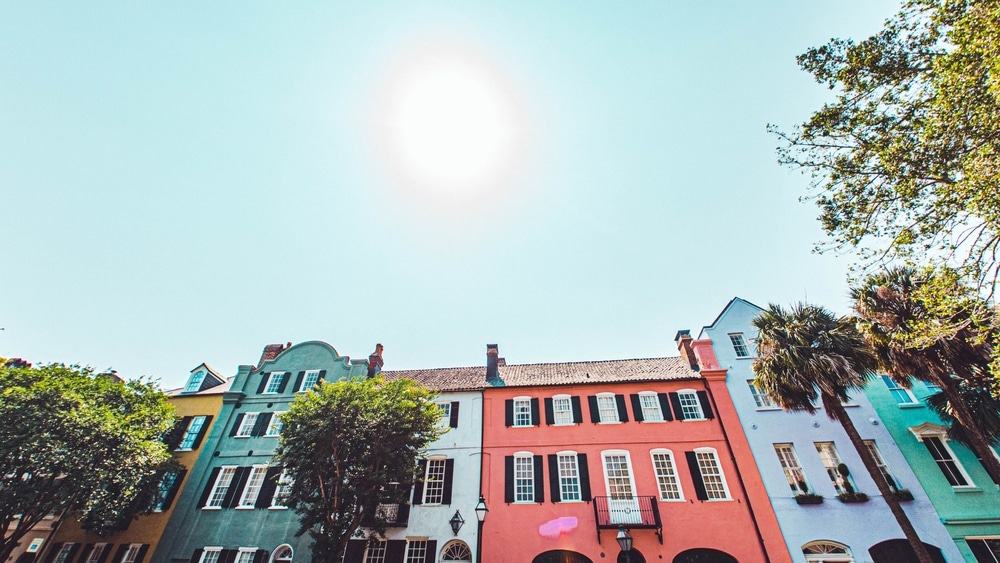
Rainbow Row is the name for a series of colorful historic houses in Charleston, South Carolina. The houses are located north of Tradd St. and south of Elliot St. on East Bay Street.
It is referred to as Rainbow Row for the pastel colors used to paint all of the houses. It is a common tourist attraction and is one of the most photographed parts of Charleston.
After the Civil War, this area of Charleston devolved into near slum conditions. In the early 1900s, Dorothy Porcher Legge purchased a section of these houses numbering 99 through 101 East Bay and began to renovate them. She chose to paint these houses pink based on a colonial Caribbean color scheme. Other owners and future owners followed suit, creating the “rainbow” of pastel colors present today. The coloring of the houses helped keep the houses cool inside as well as give the area its name.
Common myths concerning Charleston include variants on the reasons for the paint colors. According to some tales, the houses were painted in the various colors such that the intoxicated sailors coming in from port could remember which houses they were to bunk in. In other versions, the colors of the buildings date from their use as stores; the colors were used so that owners could tell illiterate slaves which building to go to for shopping.
Pitt Street Bridge
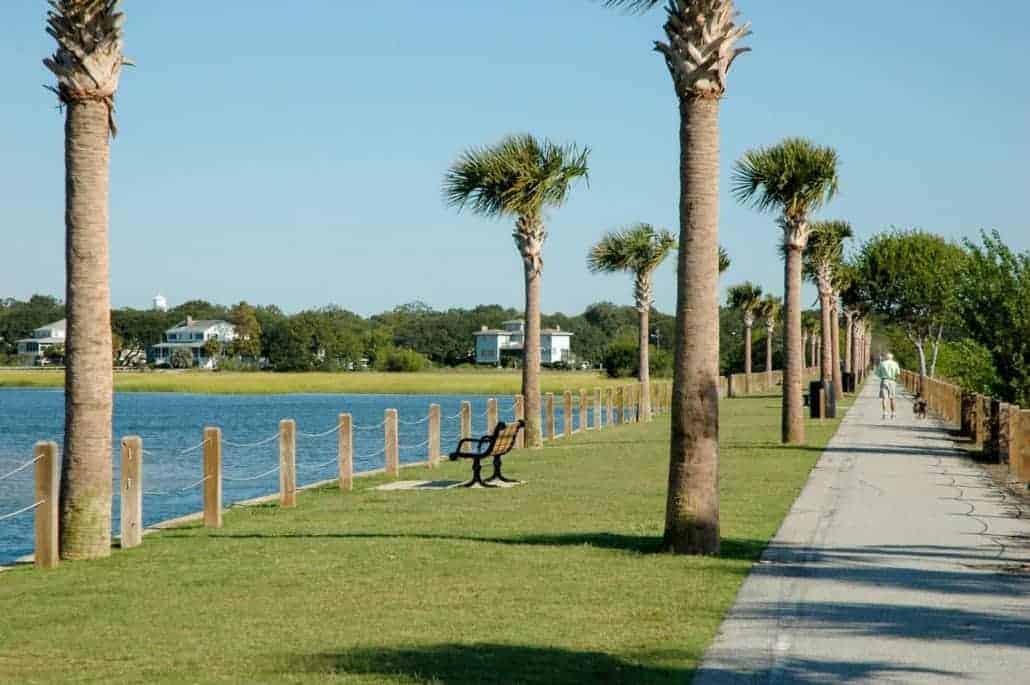
An amazing locale to see the Charleston Harbor and view evening sunsets
A bridge at the end of Pitt Street used to span Cove Inlet to connect Mount Pleasant to Sullivan’s Island. When the newer Ben Sawyer Bridge was constructed, the bridge was no longer used. The city renovated the bridge remains by creating a pedestrian greenway with sodded grass and palmetto trees. The bridge extends to roughly 1/2 of the original length, giving visitors a nice view of the surrounding intracoastal waterway. Locals walk, jog, and fish along the bridge. At the end of the walkway, you can see the remains of the old bridge as it extends toward Sullivan’s Island.
Old Slave Mart Museum
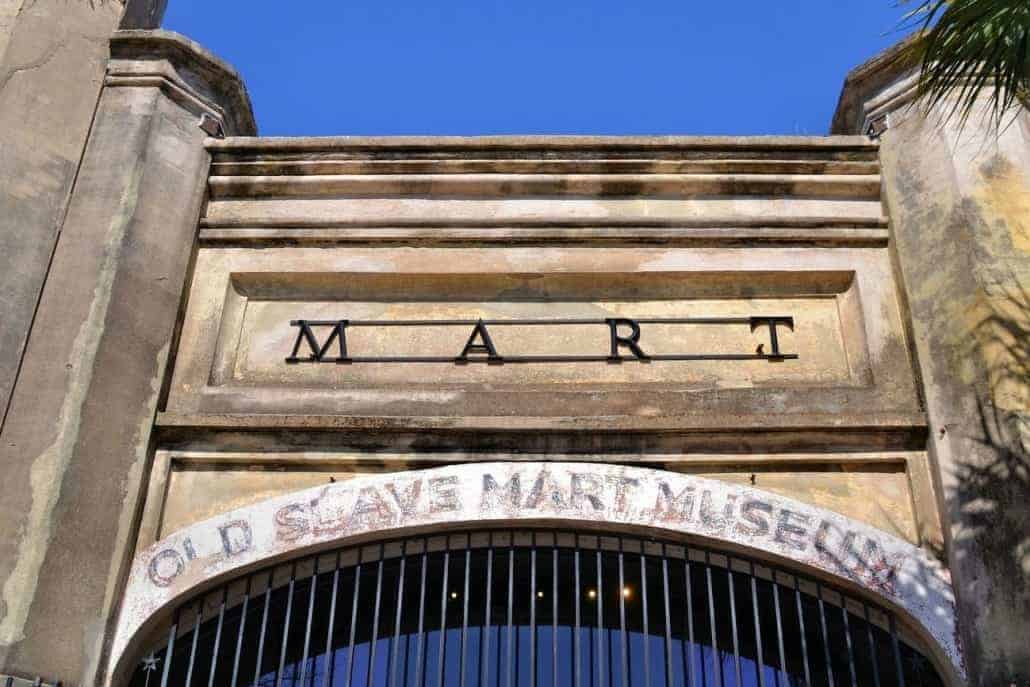
The Old Slave Mart Museum, located at 6 Chalmers St., recounts the story of Charleston’s role in this inter-state slave trade by focusing on the history of this particular building and site and the slave sales that occurred here.
History of The Old Slave Mart
The 1808 ban on the United States’ participation in the international slave trade led to a renewed demand for slave labor, which was satisfied, in part, by the creation of a domestic slave-trading system in which Charleston functioned as a major slave collecting and reselling center. The Old Slave Mart Museum, located at 6 Chalmers St., recounts the story of Charleston’s role in this inter-state slave trade by focusing on the history of this particular building and site and the slave sales that occurred here. In the seven decades between the drafting of the U.S. Constitution and the Civil War, more than one million American-born slaves were sold away from plantations in the upper South to work the rapidly expanding cotton and sugar plantations in the lower South.
In Charleston, enslaved African Americans were customarily sold on the north side of the Old Exchange Building. An 1856 city ordinance prohibited this practice of public sales, resulting in the opening of the Old Slave Mart and a number of other sales rooms, yards, or marts along Chalmers, State and Queen Streets. Other Uses Possibly the only known building used as a slave auction gallery in South Carolina still in existence, the Old Slave Mart was once part of a complex of buildings known as Ryan’s Mart that occupied the land between Chalmers and Queen Streets. The complex consisted of a yard enclosed by a brick wall and contained three additional buildings: a four-story brick building partially containing a “barracoon,” or slave jail, a kitchen, and a “dead house,” or morgue. More Recently
Slave auctions at the Old Slave Mart ended in November 1863. The property changed hands many times after the Civil War, and between 1878 and 1937 the building was used as a Negro tenement and as an auto repair shop. In 1938 Miriam B. Wilson purchased the building, which by then, had come to be known locally as the Old Slave Mart, and established a museum featuring African and African-American arts and crafts.
Judith Wragg Chase and Louise Wragg Graves took over the Old Slave Mart in 1964, placed it on the National Register of Historic Places in 1973 and operated it until its closure in 1987. Recognizing the significant importance the institution of slavery has had in Charleston’s history, the City of Charleston acquired the property in 1988.
Old Exchange & Provost Dungeon

Completed in 1771, the Old Exchange Building is a Charleston landmark and the site of some of the most important events in South Carolina history. Over the last two and a half centuries, the building has been a commercial exchange, custom house, post office, city hall, military headquarters, and museum. Previously the property of the British, United States, Confederate, and Charleston city governments, the Old Exchange Building is today owned by the South Carolina State Society of the Daughters of the American Revolution and operated by the City of Charleston.
Admission to the Old Exchange includes a self-guided exhibition on the top two floors of the building and a 25 minute guided tour of the bottom floor cellar, otherwise known as the Provost Dungeon. Docents and other staff members are available throughout the building to share more of the site’s history with visitors of all ages and answer guest questions.
Most visitors spend between 45 minutes and 1 hour on site, though guests are welcome to take as much or as little time as they like exploring the self-guided exhibition.
The Old Exchange is handicap accessible, with an elevator providing access to all three floors of the building. If someone in your party needs to use the elevator to enter the building, please feel free to call us at 843-727-2165 or speak to a cashier, and one of our docents will be glad to assist you.

